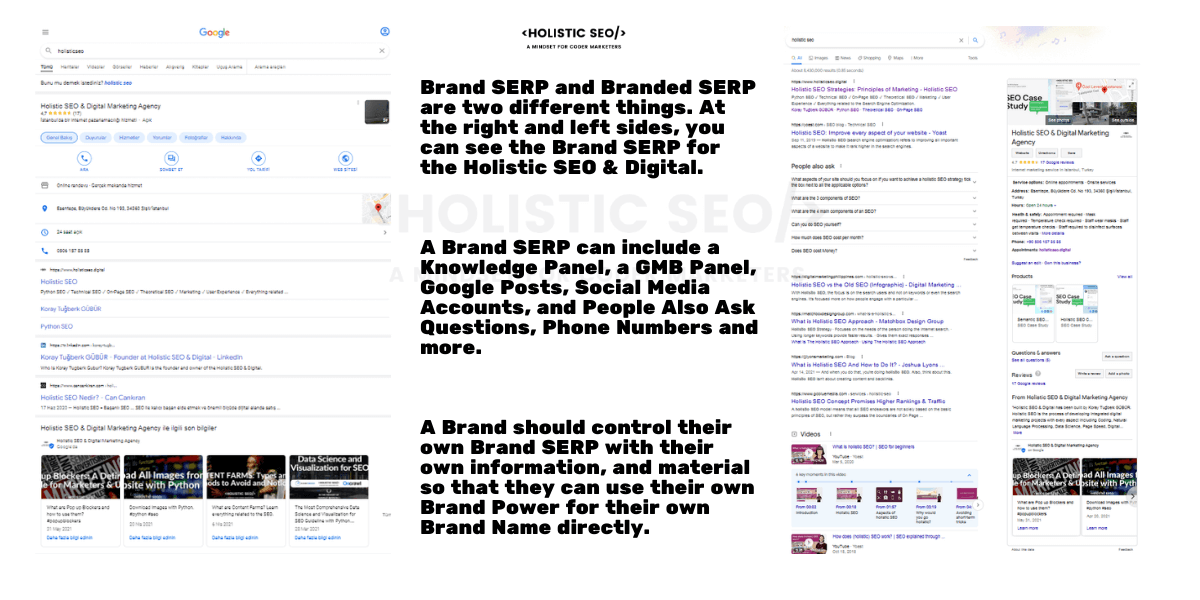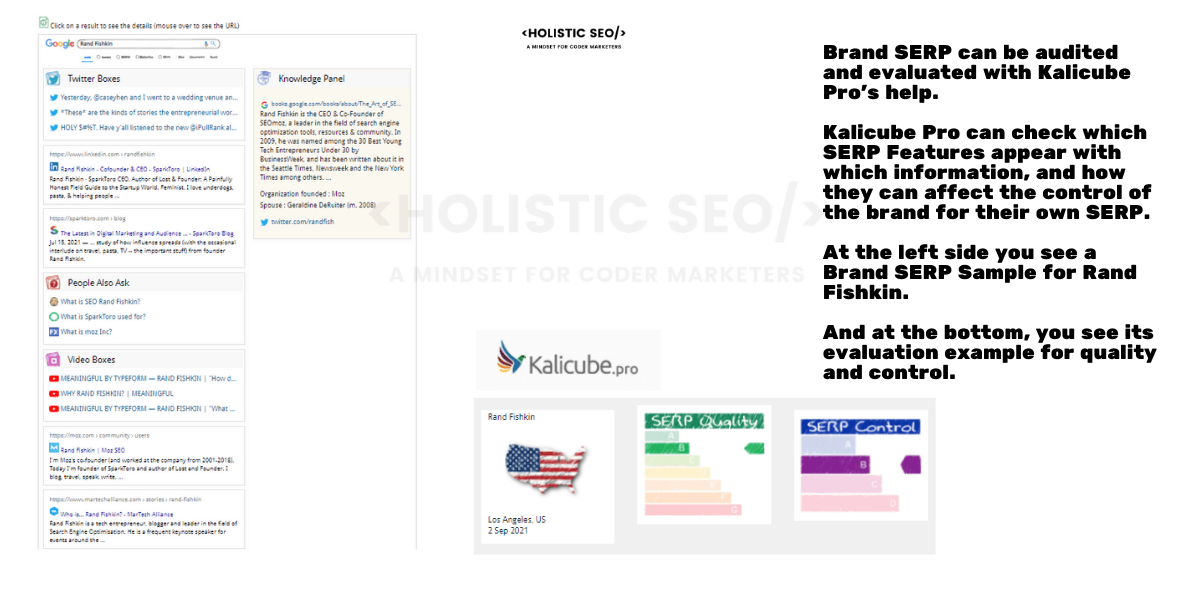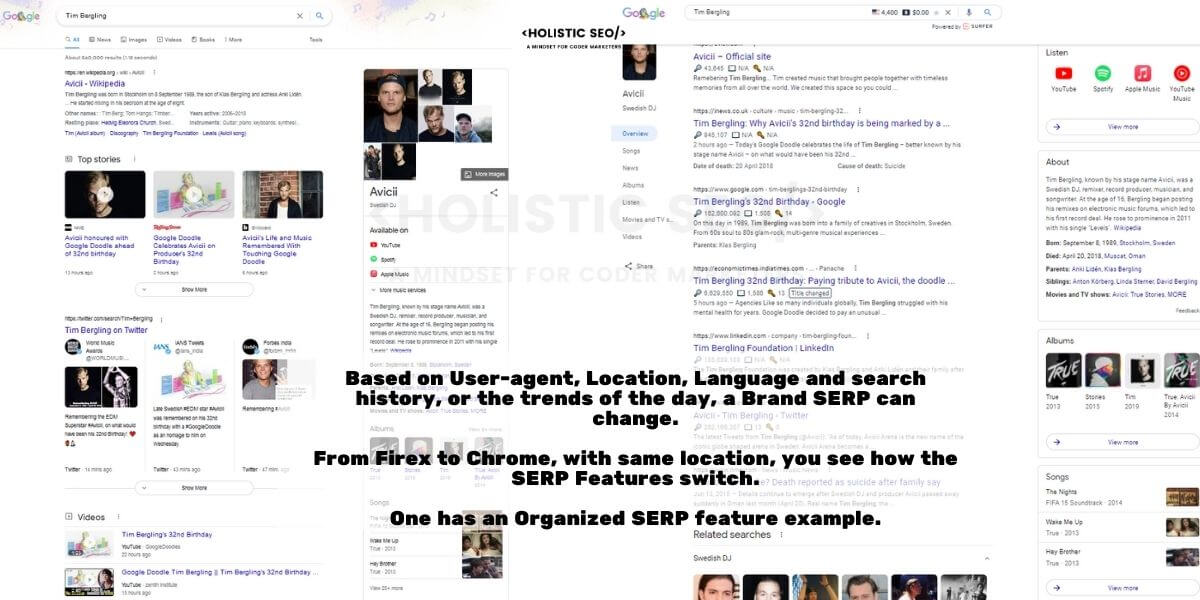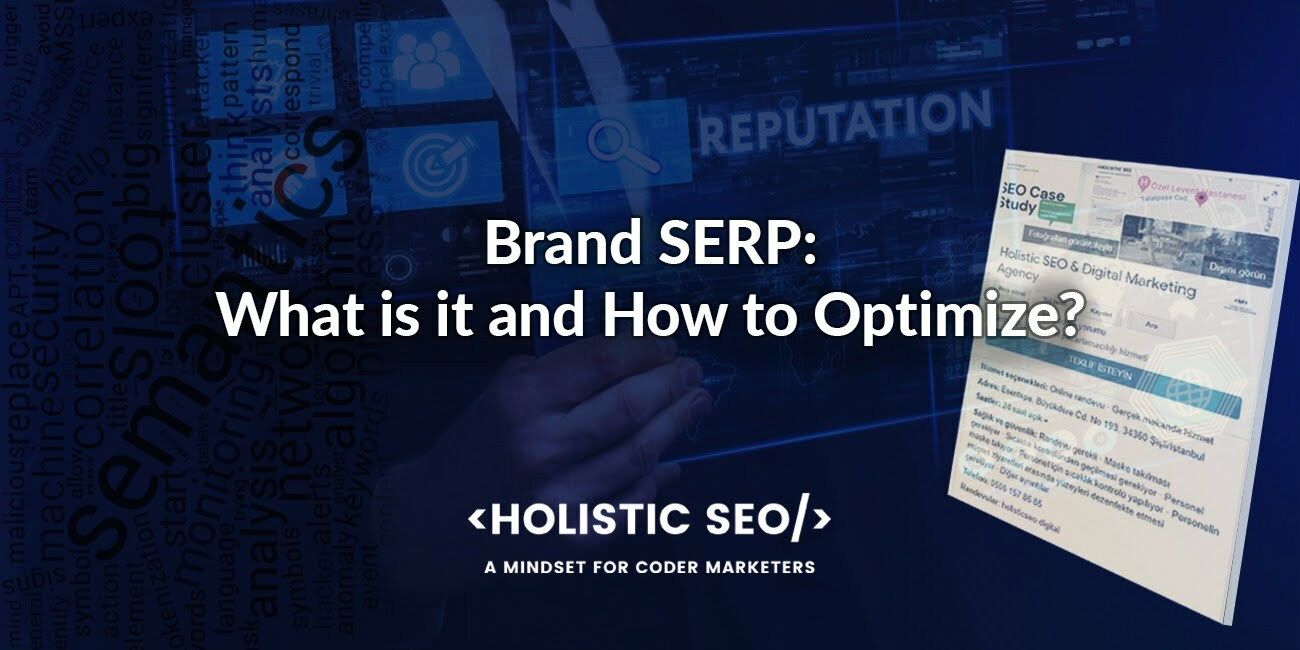Brand SERP is a Search Engine Result Page instance for a brand name, directly. Branded SERP and Brand SERP are different things. Branded SERP is a SERP instance for a branded query while Brand SERP is a SERP instance for the exact brand name itself. Brand SERP can reflect the prominence, personality, and success of a brand for the direct searchers of the named entity. Brand SERP optimization is to process of improving the search engine result page for a company, an organization, or a person. Every named entity has its own Brand SERP, and optimizing a brand SERP is useful for prestige, digital PR, SEO performance, and trust in the brand.
This Brand SERP guide and tutorial will be told related to the Knowledge Panel Optimization, entity-oriented search, and entity-oriented SEO strategies.
What is Brand SERP?
Brand SERP is the search engine result page for a navigational query related to a brand entity. A brand entity is an entity with the type of brand which has the features of an organization, and company at the same time. A brand entity’s most popular and related attributes for Semantic Search are its CEO, staff, phone number, addresses, inception date, working hours, industry, trust, expertise, service quality, and historical news about itself. Brand SERP can include complaints, cooperate information, services list, CEO’s identity, tag information, and industry-related news for the brand itself.
Within a Brand SERP, the SERP features below can be found.
- Google My Business Panel: Includes the main headquarters of the company. Potential customers can ask questions, find basic information, read customer past reviews or write new reviews.
- Search Suggestions: Popular navigational queries, or correlated queries for the brand entity or a related brand entity, and person.
- Videos Carousel: Related and Detailed Videos that define the services and identity of the brand.
- Image Pack: Visual definition of the brand whether its logo, or artwork.
- Local Map Pack: Similar headquarters of the same brand, or similar brands. If the brand name includes generic terms, the Local Map Pack will have more competition for Brand SERP SEO.
- People Also Ask Questions: Trust, Reputation and Topic related questions for a specific brand. Answering these questions directly from the brand’s owned web resources is important.
- Review Stars: Stars that show customer appreciation of the quality of the service, product, web page or article.
- FAQ Accordions: Questions and their answers shown under an organic result within the FAQ Structured Data.
- Tables within Descriptions: HTML Tables that can be shown within the Brand SERP Snippets.
- Featured Snippets: If a natural language query is used for a brand, search engine can show a featured snippet as an answer.
- Similar Entities: Other related companies, institutions, or brands can be shown by the search engine. This situation might help other brands to gain visibility from your Brand SERP.
- People Also Search For: Other entities of various types that are searched or associated with the brand by the search engine or the users.
- Top Stories: If there is news or trending topic related to the brand, Top Stories can be shown in the Brand SERP.
- News Pack: A collection of relevant News articles can be presented at the middle of the SERP by the Search Engine.
- Site-wide Links: Links to inner pages on the brand’s website that are shown below the brand’s homepage.
- Job Advertisements: Brand’s job advertisements from various sources including Google Jobs can be used in Brand SERP.

What is Brand SERP Optimization?
Brand SERP Optimization is the process of actively working to improve the brand search engine result page to remove competitors, and image-harming reviews, news, or events in the context of brand entity reputation. Brand Entity Reputation can affect the overall perception of the brand by the users. Users’ perception of a brand can affect the Search Engine’s perspective for a brand, while negative reviews, complaints, or news harm the reputation of the brand along with damaging its E-A-T (Expertise-Authority-Trustworthiness). Brand SERP Optimization can include processes commonly used in Public Relations, Press Releases, SurroundSound Campaigns, Reputation Management, and Content Marketing.
According to the anatomy, sentiment, and message of the Brand SERP, a search engine can assign a quality, trust, and prominence score to a brand for a specific topic. In this context, Kalicube Pro helps SEOs to understand which news source is more important to affect the Brand SERP and the Knowledge Graph… and Search Engines’ perception for a brand so that SEOs can focus on specific surfaces of the web to improve the Brand SERP.
“Google is your new homepage.”
Jason Barnard
How to Optimize Brand SERP?
To optimize the Brand SERP, understanding and using the Brand SERP Features is necessary. To improve the brand’s visibility, image, and clarity on the Brand SERP instance, a reflection of the brand should be given with clear details. Brand SERP features, shape, and image can affect the online reputation of a brand. To optimize the Brand SERP, the methods, steps, and techniques can be followed below.
- Answer the negative reviews for the Brand that can be reached from the Brand SERP.
- Create positive content about the brand that can be ranked within the Brand SERP.
- Make the Brand an entity within the Google Knowledge Graph.
- Associate the most important entities, concepts, and intents with the brand within the Google Knowledge Graph so that the search engine can associate the important terms and brand to each other.
- Be open about corporate related information such as staff size, CEO, privacy policy, services terms, contact, support, and headquarter address information.
- Create positive evergreen content for the brand’s reputation that dominate and replace possible negative reflections from the SERP.
- Answer common questions related to the brand to trigger the People Also Ask SERP Feature for the brand and fill it with correct and positive answers.
- Trigger a Knowledge Panel for the Brand by using the most important and authoritative sources for the specific industry with trust and notability signals.
- Improve the “about us”, and “services” pages with more granular information to generate featured snippets for brand-related navigational queries.
- Use the Google My Business Account to trigger more related SERP Features for brand related queries.
- Trigger Site-wide Links that can appear below the brand’s snippet within the Brand SERP.
- Publish videos on the Brand’s official YouTube Channel.
- Encourage industry leaders write reviews, and perform audits for the services of brand.
- Publish podcasts, and other types of contents to broaden the surface of the brand on the web.
- Use all relevant brand related hashtags on social media platforms to keep Brand SERP instances alive.
- Use a tracking and analysing SEO technology for understanding the minor changes within the Brand SERP, and brand-related Knowledge Panel instances.
- Use Google My Business Posts and products, services listings
- Use Job Advertisements to trigger more SERP Features for the Brand, and its prestige
Kalicube Pro can be used for analyzing the relevance of a brand to a concept based on Google’s Knowledge Graph. Kalicube Pro is used to create a roadmap to optimize a Brand SERP, understand the sentiment of the Brand SERP and improve the brand’s reputation and customer relations in the context of SEO.

What Can a Brand SERP Show a User?
The things that a Brand Search Engine Result Page (SERP) for a brand-related navigational query can show a user:
- Brand’s identity
- Services of brand
- Products of brand
- Addresses of brand
- CEO of brand
- The founding date of the brand
- Staff size of a brand
- Negative and Positive comments of a brand
- Videos of Brand
- Reviews of the brand
- News about the brand
- Safety and reputation related questions and their answers
- Social media accounts of brand
- Photos of the brand’s office
- Logo of the brand
- Visual assets that focus primarily on the brand
- Official website of the brand
- Motto of the brand
- Working hours of the brand
- Posts of Brand from Google My Business Account
- Questions and Answers from Google My Business Account
- Images of the Brand, and Brand’s properties, employees, or events.
To optimize a Brand SERP for a brand, all of the related Search Engine Result Pages (SERP) Features and identity-related data points should be optimized by analyzing every feature and item that a Brand SERP instance can include.
Note: As a new generation SEO Software, Kalicube Pro automatically extracts all of the Brand SERP related information from a Brand SERP instance, and make them more understandable and manageable over time with daily updates. And of course, it can also show you that status of the competitors’ Brand SERP.
What is the Importance of Brand SERP for Google and SEO?
Brand SERP’s importance is unquestionable: it represents Google’s opinion of the brand and is also a strong projection of the brand’s identity for the users. For users, this brand name navigational query reflects the brand’s services and products but also its reliability, reputation, and even its identity. The clarity of this message for the user is vital since this “Google’s summary” will affect the users’ perception of the brand itself. And for Google, that summary is the foundation of its opinion of the brand – vital in a world where entities and E-A-T increasingly dominate.
A Brand SERP is central to SEO, Marketing, and consumer behavior. The triad of “Google-user-brand trust” heavily affects not only the decision-making process of consumers but also the decision-making process of Google’s algorithms.
A Brand SERP includes two essential elements for brands.
- Trust Signals
- Reputation Signals
If a brand has a negative reputation and lacks trust from its own industry, and consumers, its Brand SERP will include negative comments, news, unclear messages, and a lack of a clear brand identity. An easy-to-see connection between trust and the Brand SERP is People Also Ask questions. For generic queries, Google generates People Also Ask questions according to their popularity and relevance in the context of the topic, while it generates the PAA questions for Brand SERPs around for trust, reputation, and brand identity. Instead of asking about the contact numbers, or story of a brand, Google includes questions for the reliability of the brand, about its regulations, safety, and related history for trustworthiness.
The negative sentiment of a Brand SERP can cause direct and indirect negative effects for the relatedness, trustworthiness, and reliability of a brand for SEO, and in the eyes of a Search Engine. The most relevant content for the brand will rank for branded queries, which is a reflection of Google’s understanding of, and opinion about the brand. If a Brand SERP has negative content, if it doesn’t have a knowledge panel, if the brand is not an entity in the knowledge graph… all of this can harm the search engine’s perception of that brand.
So, instead of focussing purely on its own site, blog, or e-commerce pages, a brand should create a clear identity for itself on the open web that covers a multitude of signals from solid trustworthy, and authoritative 2nd and 3rd party sources.
The importance of Kalicube Pro is reflected in the importance of Brand SERP for both the brand’s audience and for SEO and Search Engines. By improving the Brand SERP so that it provides a better, more reliable vision for users and search engines, a brand can increase its revenue and public relation management success.
As relevant content, you can read how to use Google Knowledge Graph API with Python.
What is the relation between Knowledge Panel Optimization and Brand SERP?
Knowledge Panel Management and Brand SERP Optimization are connected to each other. Knowledge Panel Optimization is more related to the Semantic SEO strategy, and Semantic Search than Brand SERP, but it is also an important part of Brand SERP Optimization. A Brand can have a knowledge panel on their Brand SERP by becoming an entity in Google’s Knowledge Graph. Knowledge panels exist within Yandex Search and Bing Search, DuckDuckGo, Ecosia, and other types of search engines too. But, given its market share, Google is the primary target for most brands when thinking about knowledge panels. Also, Google’s knowledge graph is bigger than other search engines. Thus, triggering and managing, optimizing a knowledge panel in Google is generally a more prominent effort for SEO. An optimized and well-structured knowledge panel will give a Brand SERP that is more rich, trustworthy, and informative, whilst making the brand more front-of-mind in the Google Search Engine within the specific industry.

What is the relation between Brand SERP Optimization and Knowledge Panel Optimization?
The Brand SERP Optimization involves Knowledge Panel Optimization as a sub-part since a knowledge panel is the part of the brand SERP. Knowledge panel management and optimization provide clarity, and definitive information for the featured of the named entity. Getting managing and optimizing a knowledge panel for improving the quality of the Brand SERP is necessary. The relation between Brand SERP Optimization and KNowledge Panel Optimization is providing the consistent, comprehensive, and definitive information for the named entity by providing factual accuracy.
To learn more about Knowledge Panel Optimization, read the related guide.
Why should you use Kalicube Pro for Brand SERP Optimization?
Kalicube Pro is an SEO software created by Jason Barnard who has specialized in brand SERPs and knowledge panels since 2015. Kalicube Pro provides tracking, update, and analysis benefits for Brand SERP Optimization by segmenting the search engine result page into different components such as PAA Questions, Featured Snippet, Knowledge Panel, Search Suggestions, Blue links, Social Media Accounts, News, Mentions and more. From changing the PAA Questions, and their answers to optimizing the news, press releases, or triggering a Top Stories, and Twitter carousel within the SERP can be made by observing changes, and spotting opportunities using the daily tracking within Kalicube Pro.
Last Thoughts on Brand SERP Optimization and Holistic SEO
Brand SERP Optimization will become a more prominent focus among the SEOs as a step within their SEO projects. Without optimizing the image, look, and prestige of the brand, the SEO project might not get a sufficiently high level of credibility for the entity from the point of view of search engines. In this context, Brand SERP Optimization with different methods, strategies, and innovations must be part of a holistic SEO strategy. Changing the general “point of view” of a search engine about a brand requires a strong website (both technically and in terms of content), digital PR, a high level of organization, analytical thinking capacity, and active attention to connecting entities on the web in order to create a “strongly connected component” relation for search engine evaluation algorithms. And (at a glance) the Brand SERP gives the SEO strategist a clear, simple, and accurate overview of all this.
The Brand SERP Optimization on Kalicube Pro algorithms are regularly improved and updated in the light of new information.
Note: Many thanks to Jason Barnard for everything he teaches and explores for the love of SEO.
- Sliding Window - August 12, 2024
- B2P Marketing: How it Works, Benefits, and Strategies - April 26, 2024
- SEO for Casino Websites: A SEO Case Study for the Bet and Gamble Industry - February 5, 2024



Thank you so much for your generous information.
Thank you, Emre.